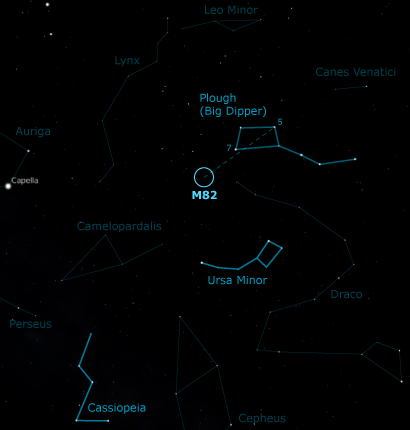Magnificent image of M82 from ESA’s XMM-Newton Telescope for the International Year of Astronomy 2009
8 April 2009
To celebrate the International Year of Astronomy (IYA) ESA is releasing a magnificent image of the starburst galaxy Messier 82 (M82) obtained with the XMM-Newton space observatory. A dedicated observation of M82 was made with XMM-Newton on 3 April 2009 as part of the IYA 100 Hours of Astronomy cornerstone project.This celebration image was produced by combining the observation taken during the 100 Hours of Astronomy with previous XMM-Newton observations of M82. The starburst galaxy M82 belongs to a class of galaxies where stars are being born at a high rate. Some of these are massive stars that lead frantic, short lives which end violently as supernovae explosions. Regions of this intense star formation can be identified in the image as bright knots in the plane of the galaxy. To find out more about the features of M82 revealed in this image and about how this image was composed click on the image below.
 |
Try observing M82 yourself
The XMM-Newton space observatory simultaneously collects X-ray light of different energies as well as visible and ultraviolet light providing a unique and profound view of M82. Thankfully, X-rays cannot penetrate Earth’s protective atmosphere. Therefore this aspect of XMM-Newton’s image is impossible to capture with ground-based telescopes.
It is possible however to see the visible light emitted by M82 and it is fairly easy to find, even if you are new to observing deep-sky objects with a telescope or binoculars. If you don’t have a telescope or binoculars, although M82 is not visible to the naked eye, take a look at some of the bright constellations close by as shown in the star map at the bottom of the page. Here is some basic information to help find M82 and some bright constellations.
| Basic data for Messier M82 | |
|---|---|
|
Discovery |
1774 by Johan Elert Bode |
| Other names |
the Cigar Galaxy, Bodes Galaxy, NGC 3034 |
| Distance |
12 million light years |
| Coordinates |
Right Ascension 09:55.8 (h:m) Declination +69:41 (deg:m) |
| Visual brightness | 8.4 (mag) |
| Apparent dimension | 9x4 (arc min) |
To find M82 first locate the part of the Ursa Major constellation that is commonly known as the Plough or Big Dipper. From most European countries the Plough will appear fairly high in the night sky during the spring. As shown on the map below, follow the fifth star in from the end of the handle of the Plough and draw a diagonal line across the bowl to the seventh star. If you continue this line moving about the same distance again you will reach the location of M82.
When observing M82 through binoculars or a telescope you may notice a close-by galaxy called M81 that is a little brighter than M82. With the correct field of view it is possible to view both of these galaxies at the same time.
To observe M82 first make sure that the sky is clear and that you are away from the polluting street lights. This is particularly important if you are attempting to observe using binoculars.
The following star map was taken from ‘Stellarium’ a free open source planetarium for your computer that shows a realistic sky in 3D and can be set to display the sky from your location.
 |
 |
